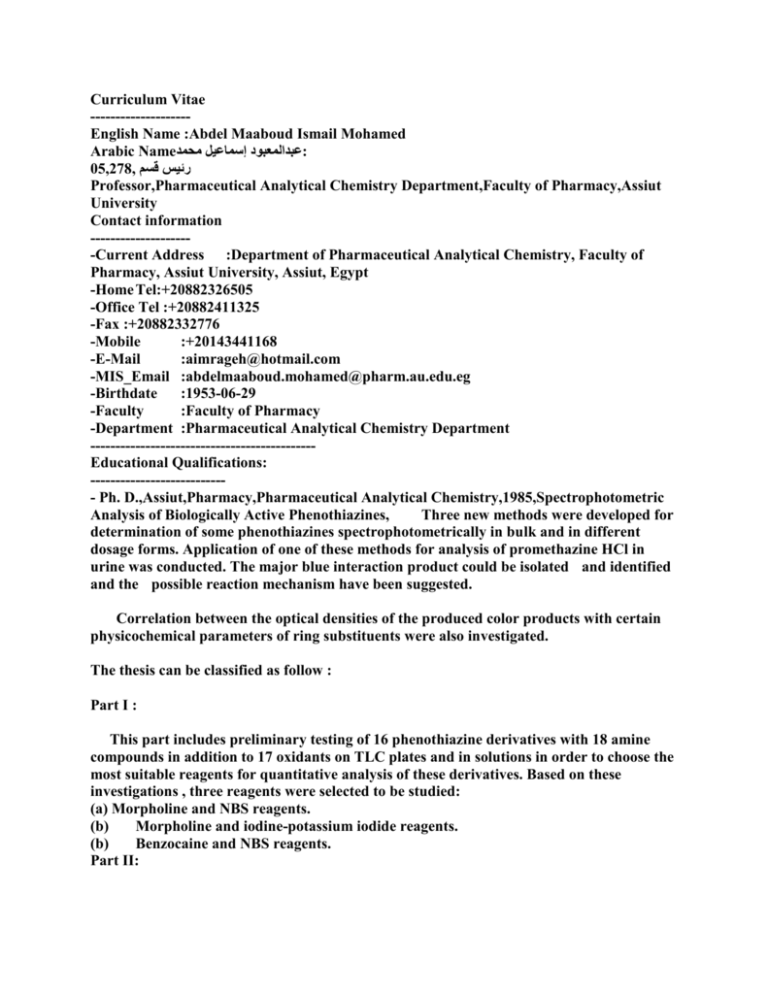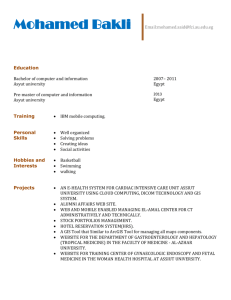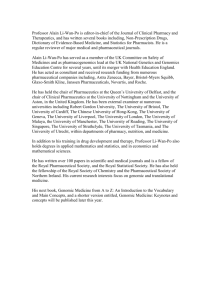Curriculum Vitae -------------------
advertisement

Curriculum Vitae -------------------English Name :Abdel Maaboud Ismail Mohamed Arabic Nameعبدالمعبود إسماعيل محمد: 05,278, رئيس قسم Professor,Pharmaceutical Analytical Chemistry Department,Faculty of Pharmacy,Assiut University Contact information --------------------Current Address :Department of Pharmaceutical Analytical Chemistry, Faculty of Pharmacy, Assiut University, Assiut, Egypt -Home Tel:+20882326505 -Office Tel :+20882411325 -Fax :+20882332776 -Mobile :+20143441168 -E-Mail :aimrageh@hotmail.com -MIS_Email :abdelmaaboud.mohamed@pharm.au.edu.eg -Birthdate :1953-06-29 -Faculty :Faculty of Pharmacy -Department :Pharmaceutical Analytical Chemistry Department --------------------------------------------Educational Qualifications: --------------------------- Ph. D.,ِAssiut,Pharmacy,Pharmaceutical Analytical Chemistry,1985,Spectrophotometric Analysis of Biologically Active Phenothiazines, Three new methods were developed for determination of some phenothiazines spectrophotometrically in bulk and in different dosage forms. Application of one of these methods for analysis of promethazine HCl in urine was conducted. The major blue interaction product could be isolated and identified and the possible reaction mechanism have been suggested. Correlation between the optical densities of the produced color products with certain physicochemical parameters of ring substituents were also investigated. The thesis can be classified as follow : Part I : This part includes preliminary testing of 16 phenothiazine derivatives with 18 amine compounds in addition to 17 oxidants on TLC plates and in solutions in order to choose the most suitable reagents for quantitative analysis of these derivatives. Based on these investigations , three reagents were selected to be studied: (a) Morpholine and NBS reagents. (b) Morpholine and iodine-potassium iodide reagents. (b) Benzocaine and NBS reagents. Part II: This part concerns with the development of two new methods for quantitative analysis of phenothiazines, using two sets of reagents: (a) Morpholine and NBS reagents, for only C-2 unsubstituted phenothiazine derivatives. (b) Morpholine and iodine-potassium iodide reagents for only C-2 unsubstituted and C-2 substituted phenothiazines with -values not more than 0.23. The procedures were optimized and applied to thirteen phenothiazine drugs in pure forms as well as in pharmaceutical formulations. The proposed methods involve the formation of methylene blue like dye stuffs in aqueous methanolic medium. The developed colored interaction products in all cases show two prominent absorption peaks. The shorter max(s) ranged from 620 - 640 nm, while the longer ranged from 660 - 690 nm. Beer’s law was found to be obeyed for all the studied drugs with both reagents in a wide range of concentrations. The developed colors were found extremely stable for at least 24 hours. Sensitivity, accuracy and precision for the proposed procedures were proved by different experiments. The developed methods were satisfactorily applied for analysis of the studied phenothiazines in the different pharmaceutical dosage forms and morpholoine and iodine-potassium iodide reagents for analysis of promethazine HCl in urine. The possible mechanism of the involved reactions were studied using different techniques including TLC, spectrophotometric scanning, IR, elementary analysis as well as chemical testing. Finally, correlations of the optical densities of the phenothiazine colored interaction products with certain physicochemical parameters ( and ) of ring substituents were investigated. Part III: This part deals with the use of benzocaine and NBS reagents for analysis of three phenothiazine drugs. The colored interaction products exhibited two max(s) at 630 and 672 nm in case of phenothizine base and promethazine HCl and at 640 nm in case of thiethylperazine maleate. Beer’s law was found to be obeyed for the three studied drugs. Studying of different variables resulted in optimization of all reaction conditions. Application of the procedure to the determination of prome-thazine HCl and thiethylperazine maleate in pharmaceutical dosage forms are given. - Ph. D.,ِAssiut,Pharmacy,Pharmaceutical Analytical Chemistry,1985,Spectrophotometric Analysis of Biologically Active Phenothiazines, Three new methods were developed for determination of some phenothiazines spectrophotometrically in bulk and in different dosage forms. Application of one of these methods for analysis of promethazine HCl in urine was conducted. The major blue interaction product could be isolated and identified and the possible reaction mechanism have been suggested. Correlation between the optical densities of the produced color products with certain physicochemical parameters of ring substituents were also investigated. The thesis can be classified as follow : Part I : This part includes preliminary testing of 16 phenothiazine derivatives with 18 amine compounds in addition to 17 oxidants on TLC plates and in solutions in order to choose the most suitable reagents for quantitative analysis of these derivatives. Based on these investigations , three reagents were selected to be studied: (a) Morpholine and NBS reagents. (b) Morpholine and iodine-potassium iodide reagents. (b) Benzocaine and NBS reagents. Part II: This part concerns with the development of two new methods for quantitative analysis of phenothiazines, using two sets of reagents: (a) Morpholine and NBS reagents, for only C-2 unsubstituted phenothiazine derivatives. (b) Morpholine and iodine-potassium iodide reagents for only C-2 unsubstituted and C-2 substituted phenothiazines with -values not more than 0.23. The procedures were optimized and applied to thirteen phenothiazine drugs in pure forms as well as in pharmaceutical formulations. The proposed methods involve the formation of methylene blue like dye stuffs in aqueous methanolic medium. The developed colored interaction products in all cases show two prominent absorption peaks. The shorter max(s) ranged from 620 - 640 nm, while the longer ranged from 660 - 690 nm. Beer’s law was found to be obeyed for all the studied drugs with both reagents in a wide range of concentrations. The developed colors were found extremely stable for at least 24 hours. Sensitivity, accuracy and precision for the proposed procedures were proved by different experiments. The developed methods were satisfactorily applied for analysis of the studied phenothiazines in the different pharmaceutical dosage forms and morpholoine and iodine-potassium iodide reagents for analysis of promethazine HCl in urine. The possible mechanism of the involved reactions were studied using different techniques including TLC, spectrophotometric scanning, IR, elementary analysis as well as chemical testing. Finally, correlations of the optical densities of the phenothiazine colored interaction products with certain physicochemical parameters ( and ) of ring substituents were investigated. Part III: This part deals with the use of benzocaine and NBS reagents for analysis of three phenothiazine drugs. The colored interaction products exhibited two max(s) at 630 and 672 nm in case of phenothizine base and promethazine HCl and at 640 nm in case of thiethylperazine maleate. Beer’s law was found to be obeyed for the three studied drugs. Studying of different variables resulted in optimization of all reaction conditions. Application of the procedure to the determination of prome-thazine HCl and thiethylperazine maleate in pharmaceutical dosage forms are given. - M. Sc.,ِAssiut,Pharmacy,Pharmaceutical Analytical Chemistry,1980,Mixed Anhydrides in the Analysis of Tertiary Amines of Pharmaceutical Interest ,The development of simple, facile, selective and highly sensitive methods for analysis of tertiary amine drugs in bulk and in different pharmaceutical formulations is the subject matter of this thesis which can be summarized as follow: Section I: This section involved the improvement of a previously reported method for determination of tertiary amine drugs using malonic anhydride/acetic anhydride (MAA). The improved method was developed and applied to 19 tertiary amine drugs belonging to different pharmacological groups in pure form and in pharmaceutical formulations. The method involves the condensation of malonic anhydride with acetic anhydride under the catalytic effect of the tertiary amines. The condensa-tion product shows two prominent absorption peaks at 333 and 400 nm for all studied drugs. The apparent molar absorptivity of the 333 nm band was in the range of 1.34 X 105 to 5.5 X 105. Absorbance versus concentration was found to be linear up to 1.2 mg/ml for all studied drugs and the limit of determination was about 0.1 mg/ml. A study of all variables resulted in improvement of the previously mentioned method in terms of shorter heating time, lower limits of detection and determination, higher molar absorptivities, stability of condensation products and applicability to all types of tertiary amine salts as well as the free bases. Interference experiments indicated that both primary and secondary amines as well as quaternary ammonium salts does not interfere with the determinations by the developed method. The method was satisfactorily applied to analysis of some studied tertiary amines in different pharmaceutical formulations. Section II: This section dealt with the use of phthalic anhydride/acetic anhydride reagent (PhAA) as a new analytical reagent for determination of tertiary amines. The method was based on the condensation of phthalic anhydride with acetic anhydride under the catalytic effect of the tertiary amines either free or in the form of salts. The condensation product exhibit max at 302 nm for all studied drugs with apparent molar absorptivities in the range of 5.79 X 104 to 1.08 X 105. Absorbance versus concentration was found to be linear up to 6 mg/ml for all studied drugs. Primary and/or secondary amines do not interfere with the determinations. Application of this procedure to the determination of certain tertiary amines in pharmaceutical preparations are given. Section III: This section was concerned with the use of ascorbic acid/acetic anhydride reagent as an analytical reagent for determination of tertiary amine bases. The method depends on the interaction of tertiary amines with the AsAA reagent where the amine function as a basic catalyst for the condensation of the two acid anhydrides. The condensation product exhibit max at 273, 310 and 480 nm for all studied drugs with apparent molar absorptivities of the 273 nm band (maximum sensitivity) in the range of 3.95 X 104 to 5.35 X 104. Absorbance versus concentration was found to be linear up to 10 g/ml for all studied amine drugs. Primary and/or secondary amines do not interfere with the determinations, however, other tertiary amines interfere and required prior separation. The method was satisfactorily applied to the analysis of certain tertiary amine bases in different pharmaceutical preparations. Section IV: This section dealt with investigation of the possible mechanisms of the reaction of the three systems ( MAA, PhAA and AsAA ) with tertiary amine drugs. It might be noteworthy the developed methods were the subject matter of several research articles which were presented at national, Pan-Arab and international scientific congress. - B. Sc.,ِAssiut University,Faculty of Pharmacy,1976 --------------------------------------------Academic Degrees : ------------------ Professor,Pharmaceutical Analytical Chemistry Department,Faculty of Pharmacy,Assiut University,1998 - Associate Professor,Pharmaceutical Analytical Chemistry Department,Faculty of Pharmacy,Assiut University,1990 - Lecturer,Pharmaceutical Analytical Chemistry Department,Faculty of Pharmacy,Assiut University,1985 - Assistant Lecturer,Pharmaceutical Analytical Chemistry Department,Faculty of Pharmacy,Assiut University,1980 - Demonstrator,Pharmaceutical Analytical Chemistry Department,Faculty of Pharmacy,Assiut University,1976 --------------------------------------------Administrative Positions : -------------------------- 02-09-05,278,2009, رئيس قسم - 14-02-10,2006-11-05,2004,وكيل الكلية لشئون خدمة المجتمع وتنمية البيئة --------------------------------------------Publications : -------------1 - Chemometric Methods for the Simultaneous Determination of Some Water-Soluble Vitamins,Abdel-Maaboud I. Mohamed, Horria A. Mohamed, Niveen A. Mohamed, Marwa R. El-Zahery,Journal of AOAC International,Vol.94, No. 2 ,PP. 467-481,2011 2 - Simultaneous Separation and Determination of Lamivudine and Zidovudine in Pharmaceutical Formulations Using the HPTLC Method,Girum Habte1, Ariaya Hymete1, Abdel-Maaboud Ismail Mohamed1,2,Analytical Letters,vol. 42,pp. 1552 –1570,2009 3 - Determination of Lamivudine and Stavudine in Pharmaceutical Preparations Using Chemometrics-Assisted Spectrophotometry,Abd El-Maaboud I. Mohamed1,2, Workalemahu Mikre1,Saudi Pharmaceutical,vol. 17,pp. 275 - 281,2009 4 - 1,2-Dihydroisoquinoline-N-Acetic Acid Derivatives as New Carriers for Specific Brain Delivery I : Synthesis and Estimation of Oxidation Kinetics Using Multivariate Calibration Method.,Sahar Mahmoud, Tarek Aboul-Fadl, Mahmoud Sheha, Hassan H. Farag and Abdel-Maboud I. Mouhamed., Arch. Pharm.Pharm. Med. Chem. ,336,573-584,2003 --------------------------------------------Supervisions : -------------1 - Marwa Refaat mohamed El Zuheiry,Spectrophotomrtric and Spectrofluorimetric Analysis of Some Vitamins in Pure Forms and in Pharmaceutical Combinations,M. Sc,2006-04-30,Abdalmaeod Ismail Mohamed , haria Abdal Majid Mohamed, Nevine Abdel-Latif Mohamed 2 - Hassan Rifaat Hassan Ali,Physicochemical Study and Spectrofluorometric Determination of Certain Local Anesthetics,M. Sc,2001-12-30,Salwa Rizk ElShabouri ,Abdel Maaboud Mohamed Ismail , Hanaa Mohamed Abdaludod --------------------------------------------Awards : ----------------*****-----------------------------






